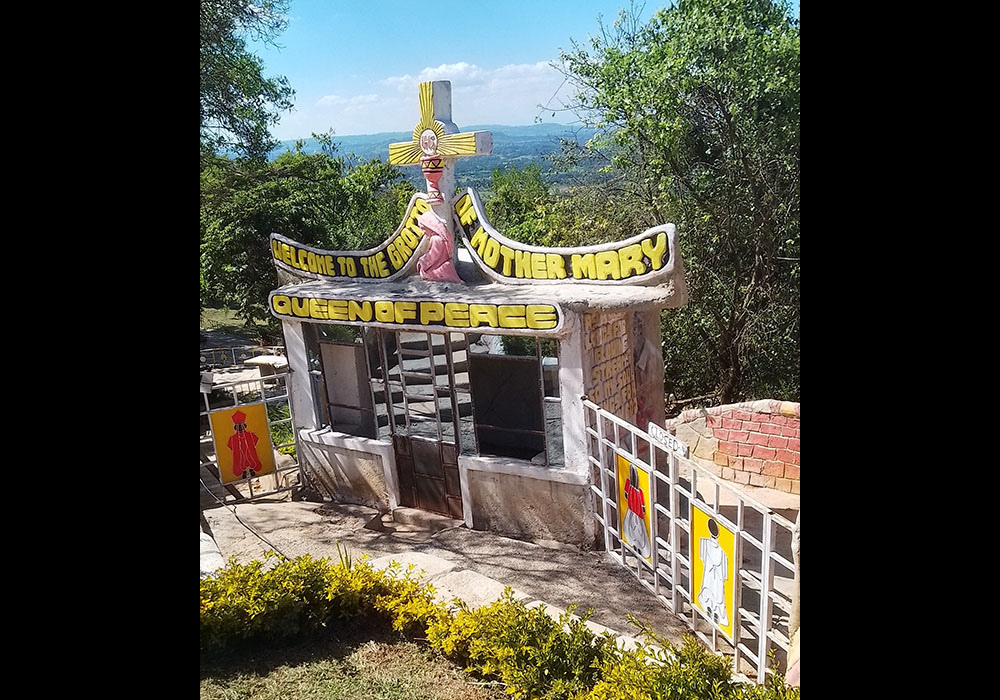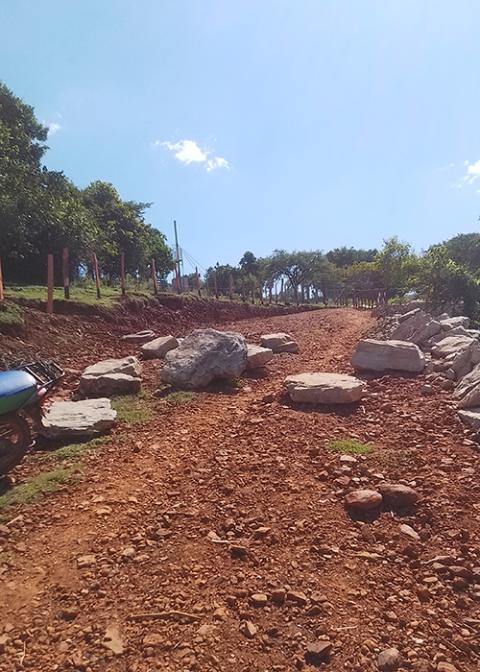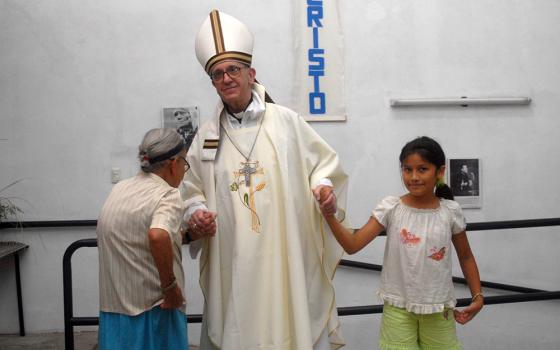
Mother Mary Queen of Peace Shrine sits atop Kabiyet Hill in western Kenya. Established by the Catholic Diocese of Eldoret, it has become a site of community gathering and environmental conservation. (Shadrack Omuka)
Kabiyet Hill has been a center for relaxation and prayer for decades in this expansive part of western Kenya. Now it is also home to a Catholic shrine that provides a shared space for worship while also facilitating conservation efforts to address environmental degradation in the area.
Located about 4 kilometers (2.5 miles) from the town of Kabiyet, this hill is historically significant among the Nandi community, of the larger Kalenjin tribe in Kenya's vast Great Rift Valley.
For the Nandi people the hill was a sacred site, the home to their god Asis. Their elders for years led cultural rituals and prayers at Kabiyet Hill, asking divine intervention for rains, good harvests and justice.
During the 1920s, when Kenya was under British rule, the colonial government set up an administrative office at Kabiyet Hill and installed radio communication towers on the site.
It wouldn't be until August 2023 that Kabiyet Hill was resurrected as a place of worship. That month, the Catholic Diocese of Eldoret, under the direction of Bishop Dominic Kimengich, erected a monumental crucifix atop the 250-meter-tall hill and officially rededicated the site as the Mother Mary Queen of Peace Shrine. Kimengich established the shrine in 2022.
It is the first Catholic shrine of its kind in Kenya's north Rift Valley region, an expansive area encompassing eight counties and six Catholic dioceses.
Fr. Fredrick Keter, the shrine rector, said the diocese sought to establish a shrine at the hill as an alternative for out-of-practice traditions as well as to enhance conservation efforts.
"Residents of Kabiyet wanted to shift from traditional practices which were no longer working for them to modern Christianity, where they will have to worship God and not gods," Keter said.
Nandi elders attended the rededication of Kabiyet Hill as the Mother Mary Queen of Peace Shrine. While some opposed the idea of a Catholic shrine at the site, Nandi elders and the church worked to resolve issues. Eventually, the church and community reached an agreement and the shrine was built, said James Rono, a Nandi community elder who is also Catholic.
"We're very much welcoming the presence of the church here," Rono said.
Visiting Kabiyet shortly after the Catholic shrine was opened, Soipan Tuya, then Kenya's cabinet secretary for environment, forestry and climate change, said that introducing it in a village where people have been relying on traditional practices represented a milestone development that will bring transformation, adding that the church plays an important role in cultivating positive values.
A towering statue of Jesus on the cross now sits atop Kabiyet Hill, visible from great distances away and greeting pilgrims with scriptural passages carved in stone steps at its base. Elsewhere on the grounds is a grotto housing another imposing statue, this one of Mary, painted in cloaks of blue and red, holding the baby Jesus.

New roads are under construction at Mother Mary Queen of Peace Shrine, on Kabiyet Hill, along with conservation efforts like soil restoration and planting of indigenous trees. (Shadrack Omuka)
Changes at the Kabiyet Hill shrine haven't stopped with additions of sacred imagery, Keter told EarthBeat, as several projects are in progress.
"Right now we're working on roads to the shrine, constructing the church that will accommodate about 3,000 people and other infrastructure like electricity and water supply," the rector said. "We’re also planting trees, especially the indigenous ones and building of gabions [support cages filled with rocks or soil] to control the flow of runoff."
More trees will be added at the hill, Keter said, to create a good environment for pilgrims to relax and pray in peace.
The shared belief that God is present in the mountain, he added, can bring together both the church and the surrounding community to worship at the hill.
"We do believe that the same perspective will cement the relationship between the church and the community here at Kabiyet," the priest said.
Though Kabiyet Hill was considered a sacred place by the Nandi community, little was done to protect the environment. Tree stumps and soil erosion around the hill indicated signs of neglected and degraded land. Poor agricultural practices, overgrazing, excessive logging and demand for wood fuel have all played a role.
"Kabiyet Hill Shrine needs serious conservation efforts to save the place from degradation, which seems to be worsening," said Joseph Langat, a conservationist and a parishioner at St. Joseph the Worker Catholic Church in Kapyiemit.
Development of the new shrine will see the hill altered as well, as new road construction will involve cutting down some indigenous trees, and air pollution may periodically increase from the use of cement and other materials. Still, church leaders and local elders alike remain confident the project will have an overall positive impact on the local community and ecosystem.
"[The Catholic Church is] well known for our environmental conservation," said Keter, pointing to other efforts to restore dwindling ecosystems the church has undertaken at Subukia Shrine, Kakamega Forest, the Maragoli Hills and the forests around Mount Kenya.
At the Mother Mary Queen of Peace Shrine, parishioners and volunteer members of the Nandi community have begun planting indigenous trees to restore the degraded parts of Kabiyet Hill.
"It is from here, on this hill, that our community elders for many decades have been coming to pray for rains and good harvest, our god [Asis] exist here and now the church has come also to boost our faith," Rono, the Nandi community elder, said.
"This hill will be more powerful than before."
Rono told EarthBeat that combining Indigenous tradition with Christianity will enhance many things in the community, including morals among the youth, and help in protecting the environment at the holy place, including through the teachings of Pope Francis' encyclical "Laudato Si', on Care for Our Common Home."
"Nobody can oppose this as the hill belongs to the community and this is our church," Rono said. "No land has been lost and nobody has any right to complain. The community will continue with their cultural activities while the church promotes devoutness."
Advertisement
The Nandi community elder added that both the church and the community had agreed about the shrine's construction. Since the land belongs to the community, no conflict is expected. Even as some in the community initially voiced opposition, most welcomed the change in this area with a sizable Catholic population.
Samuel Misoi, the chairman of the Catholic Men Association, said the shrine is the center of worship and prayers for the Nandi community that has relied on traditional practices for centuries.
He said the new shrine will attract pilgrims and tourists alike, from across Kenya and beyond. For the local community, it will also serve as a space for meetings and functions. Another advantage of the shrine, Misoi said, is that it will draw more community members to the church, while at the same time spreading awareness about environmental conservation not only around the hill but across the village and other regions.
Misoi admitted that as a church they still have more to do both in terms of infrastructural development and conservation efforts, like planting trees across the hill to curb erosion and other steps to cultivate a tranquil atmosphere at the shrine for all visitors.
With such changes, the rector Keter said the hope is they will eventually benefit the surrounding community, both spiritually and ecologically.





